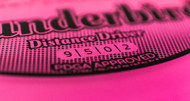Disc Golf Flight Numbers Explained: Speed, Glide, Turn, and Fade Made Simple
Posted by Shannon on Jul 22nd 2025
What Do the Numbers on a Disc Golf Disc Mean?
If you’ve ever picked up a disc and seen something like Speed 9 | Glide 5 | Turn -2 | Fade 1 stamped on it, you might’ve wondered what in the world that even means. Don’t worry—you’re not alone. I get this question all the time at both of our shops here in Austin (South Store by Mary Moore Searight Disc Golf Course and our North location near Wells Branch Disc Golf Course).
These numbers are called flight numbers, and they give you a rough idea of how a disc is supposed to fly. It’s not perfect science (everyone throws a little different), but it’s super helpful when you’re learning or trying out new discs.
Here’s a Quick Breakdown of Each Flight Number
1. Speed
This is the first number, and it ranges from 1 to 14. It tells you how fast the disc needs to be thrown to fly properly. Higher speed means a sharper edge and a longer flight—but it also means it takes more arm strength or snap to get it flying right.
Pro tip: If you’re newer to the game, don’t chase speed 12 or 13 drivers right away. You’ll get more distance and control with a speed 7–9 fairway driver until your arm gets stronger.
2. Glide
This is how much the disc wants to stay in the air. Higher glide means more hang time and usually more distance. A disc with a glide of 6 floats forever. A disc with glide 3 comes down quicker, which can actually be helpful in windy conditions or shorter shots.
Think of glide like this: Wanna stay up? Grab high glide. Wanna sit down? Go low glide.
3. Turn
This is where it gets a little tricky. Turn is the disc’s tendency to turn right (for a right-handed backhand throw) during the first part of the flight. It’s usually a negative number like -2 or -3, which means it’ll “flip up” or turn more.
If it’s 0 or +1, the disc is more stable and resists turning.
New players: Look for a disc with a little turn (-1 to -3) to help with getting more distance. Too much stability early on can make a disc feel like a brick.
4. Fade
This is what the disc does at the very end of its flight. Fade is how much it hooks left (again, for a righty backhand). A fade of 3 or 4 will finish hard left. A fade of 0 means it’ll finish super straight—or even keep turning.
Rule of thumb: High fade = big hook at the end. Low fade = smoother, straighter finish.
Let’s Put It All Together
Take a disc like the Innova Leopard (one of my favs) — it’s rated 6 | 5 | -2 | 1.
- Speed 6: Easy to throw
- Glide 5: Stays up in the air
- Turn -2: Flips a little for more distance
- Fade 1: Gentle finish
Great beginner disc, and honestly, I still carry one because it’s just reliable when I wanna shape a smooth line in the woods.
More Examples from My Own Bag
Here are a few other discs folks around Austin love—and how their flight numbers tell the story:
Discraft Buzzz – 5 | 4 | -1 | 1
- Speed 5: Right in that sweet spot for a midrange
- Glide 4: Carries nicely, but not floaty
- Turn -1: Flips just a hair when thrown flat
- Fade 1: Gentle fade at the end, super controllable
This one’s a workhorse. I use it on tight fairways and approach shots. If you throw it clean, it’ll go laser-straight. New players love it because it’s predictable but still teaches good form. I always tell folks: if you only carry one midrange, make it a Buzzz.
Innova Destroyer – 12 | 5 | -1 | 3
- Speed 12: This one needs some juice—definitely not beginner-friendly
- Glide 5: Big carry potential if you can get it moving
- Turn -1: Will flip up slightly with power
- Fade 3: Reliable strong fade at the end
This is a bomber disc for experienced players. If you’ve got the arm speed, it’ll fly forever with a nice “S” shape. If you’re still building power, it’ll probably hyzer out early—but hey, it’s great for learning how to shape lines with more fade.
Mint Discs' Bullet – 2 | 4 | 0 | 1
- Speed 2: Classic putter speed—slow and steady
- Glide 4: Really floats for a putter
- Turn 0: Stays straight as an arrow
- Fade 1: Just a baby fade at the end
This thing is deadly straight. I use it for upshots that need to stay on track and not skip past the basket. Mint’s based right here in Texas too, which is just icing on the cake. I recommend the Bullet to folks who want one putter that can handle both putting and short drives.
Final Thoughts
Flight numbers don’t tell the whole story—plastic type, disc weight, nose angle, and even how you release the disc all matter too. But once you start paying attention to these numbers, you’ll have an easier time figuring out what to bag and when to throw it.
If you ever want help picking a disc that matches your throw, just swing by one of the shops. I love talking plastics, numbers, and helping folks level up their game.

